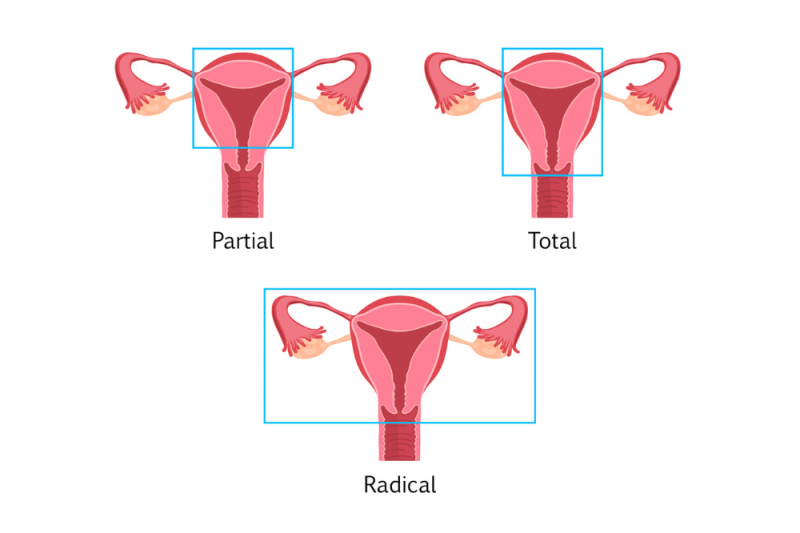
A woman in a red dress stands in a hospital ward in front of a row of beds. In the background a hospital worker is making one of the beds
Hysterectomy is an operation to remove the uterus (womb).
The surgery may or may not also remove the cervix, ovaries, or fallopian tubes.
In Australia, about 32,000 hysterectomies are performed each year, or about 255 per 100,000 women.
Quick links
- The uterus
- Reasons for hysterectomy
- Types of hysterectomy
- Methods of hysterectomy
- Recovery
- Mental health
- More information
The uterus
The uterus is an organ in the lower abdomen with muscular walls. It is the organ that hosts and nurtures a developing baby.
In sexually mature females, the lining of the uterus (the endometrium) periodically becomes thicker. This is to be ready to receive a fertilised egg (ovum). Eggs are fertilised by sperm. A fertilised egg received by the endometrium can grow into a foetus, or baby.
If the egg is unfertilised, the endometrium falls off the uterus wall. This is experienced as bleeding (known as menstruation or a period).
If a woman has a hysterectomy, removing the uterus, she will no longer menstruate. She will not need contraception to avoid pregnancy, nor will she be able to conceive a child.
Reasons for hysterectomy
There are a wide range of conditions where hysterectomy may be indicated. These include:
- cancer—of the uterus, cervix, fallopian tubes, or ovary
- fibroids—non-cancerous growths (tumours) in the uterus
- endometriosis—cells similar to endometrium grow in other areas of the body
- adenomyosis—cells similar to endometrium grow in the muscle of the uterus
- severe period pain—due to adenomyosis or severe endometriosis
- heavy or irregular menstrual bleeding (besides hysterectomy, newer techniques and treatments are now also available)
- pelvic inflammatory disease—caused by bacterial infection, often from sexually transmitted infections (STIs)
- prolapsed uterus—damaged pelvic floor muscles or loose ligaments cause the uterus to fall into the vagina.

Types of hysterectomy
There are different types of hysterectomy.
A ‘total hysterectomy’ is where the cervix is removed with the uterus. The cervix is the lower, narrow end of the uterus that forms the canal between the uterus and vagina. A total hysterectomy is the most common type.
A ‘subtotal’ hysterectomy is where the uterus is removed, but the cervix is not.
If required, and appropriately consented, one or both ovaries may also be removed in older women. Generally, removal of ovaries is not a routine part of a hysterectomy
Before you have the operation, you should be clear about the type of hysterectomy planned. Find out whether the ovaries or fallopian tubes are to be removed. This will depend on your personal circumstances. Talk to your doctor.

Methods of hysterectomy
There are different surgical methods used for hysterectomy:
- Abdominal surgery—where the uterus is removed through a cut made in the lower abdomen.
- Vaginal surgery—the uterus is removed via the vagina.
- Laparoscopic surgery—also known as keyhole surgery. Small cuts are made in the abdomen—often in or near the bellybutton. Small surgical tools and a narrow tube with a light and a small camera (laparoscope) are passed through.
- A combination of laparoscopy and vaginal surgery.
Vaginal and laparoscopic surgeries generally have lower risks of infection and blood loss than abdominal surgeries. They have shorter recovery times and hospital stays.
Recovery
Hysterectomy is generally a safe procedure. But all surgery comes with some risks such as infection, blood loss, or reaction to anaesthesia (being put to sleep). If you have concerns, discuss them with your doctor.
Some vaginal bleeding and discharge may be experienced for a week or two after surgery.
During recovery, it’s best to avoid doing anything strenuous for four to six weeks.
If you experience any of the following symptoms, you should contact your doctor:
- pain keeps getting worse
- redness, pain or swelling of the wound
- heavy bleeding
- bad-smelling discharge.
Mental health
Hysterectomy can be challenging and emotionally difficult for some women. They may worry that they have changed something important to them or have done something irreversible. Help is available: talk to your doctor.
Many others experience relief from the symptoms they had before the surgery and feel much better.
More information